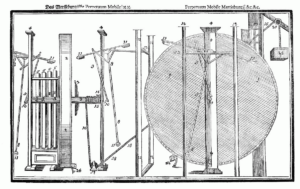Could one of Europe’s largest treasure troves be hidden somewhere in the darkness of a former Nazi tunnel system in Poland? Since World War II, rumors have circulated in the small town of Wałbrzych in Lower Silesia that an armored train containing gold, silver, precious stones, art, and weapons lay hidden in a sealed location nearby.
Background
During the war, the Nazis looted occupied territories, plundering palaces, art galleries, and museums, and also dispossessed Jews of their property and possessions. As a result, the regime accumulated vast wealth.
Nazi treasures were stashed throughout Europe. After defeating the Nazis, Allied forces came across hoards of valuable items, ranging from solid gold bars to classical art sculptures. US forces found loot stashes in the wild, in Nazi Party officials’ houses, and on trains. In 1944, American soldiers came across a train in Austria that carried thousands of boxes of gold and silver objects, gems, cash, china, rugs, and art stolen from Hungarian Jews.

Original colorized photograph of the Amber Room in 1931. Photo: Special Collections at UC Santa Cruz
A famous example of looting was the infamous Amber Room, a chamber within Russia’s Catherine Palace. Sometimes cited as the “eighth wonder of the world”, the architecture and interior design was a work of art. Its walls contained amber panels and carvings topped with gold leaf, mirrors, gems, and priceless classical art. The Nazis completely dismantled the room and shipped it off to Königsberg, where its pieces and all documentation disappeared as the Allies approached.
In 1946, a committee called the Tripartite Commission for the Restitution of Monetary Gold attempted to track down, catalog, and return stolen valuables to their original owners. By the end of the war, the Americans had confiscated five million valuable items. But rumors of unrecovered treasures persisted.
The gold train
A picturesque Polish city called Wałbrzych gained notoriety when word of possible Nazi treasure began to spread. Supposedly, a group of German workers witnessed treasure being carried into tunnels within the nearby Owl Mountains. According to legend, the train holds 300 tonnes of gold, silver, jewels, art, and other valuables. Some believe that Amber Room pieces could also be on this train.
The Owl Mountains housed a mysterious Nazi project called “Project Riese”. They chose these mountains for the extremely sturdy rock that could withstand bombardments. The project entailed the construction of tunnels, underground bunkers, and shelters built by over 5,000 laborers from concentration camps. But Project Riese’s purpose and objectives remain unclear to this day.

Tunnels in the Owl Mountains. Photo: Ewaplesna/Shutterstock
It is possible that the Nazis intended to use the tunnel system for transportation purposes but other theories suggest they used them for weapons development or as a subterranean headquarters.
Legend has it that the Nazis loaded an armored train with treasure as the Red Army advanced before the train disappeared into one of the tunnels beneath Ksiaz Castle in northern Wałbrzych.
After 1945, there were several investigations into the tunnels, including by the Polish Army, but there was no sign of a Nazi train overflowing with gold.
Recent treasure hunts
In the summer of 2015, treasure hunters Piotr Koper (Poland) and Andreas Richter (Germany) shocked the town when they claimed to have located the train. Using radar imaging, they captured an image of an object 100m in length near the 65km mark of the Wroclaw-Wałbrzych line.

Ksiaz Castle in Poland. Photo: Haidamac/Shutterstock
They made a deal with the Polish government and settled on a 10% finder’s fee if they found the gold-laden train. Their discovery caused a frenzy and the town saw an increase in tourism. Police and army officials went as far as securing the area to prevent civilian and media interference with the investigation.
Deputy Culture Minister Piotr Zuchowski stated that he was “99% certain that the train exists…definitely an armored train like those from the war. That’s what it looks like.”
The Polish government made several searches between 2015 and 2016, funded by the government and private financiers. But there was no sign of the train. Instead, Koper and Richter’s radar imaging appeared to show ice formations.
You can imagine the disappointment felt by the two train enthusiasts and an eager public. Koper and Richter refused to give up and opted to drill down another 20m, where they came across a set of promising cavities. However, there was still no train in sight.
Richter gave up the search in 2018, but Koper continues to hold out hope that someone will one day find the train.
Theories
Project Riese is still shrouded in mystery because of the lack of documentation (most likely destroyed as the Soviets advanced), and so it is possible that the train could be in an undiscovered tunnel. Some parts of the tunnel network are inaccessible after collapses. Perhaps, the Nazis wished to deny the Allies access by detonating the entrances to certain tunnels.
Or, as seems more likely with each passing year, the Nazi gold train is merely a case of unsubstantiated rumor.






